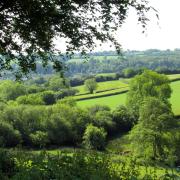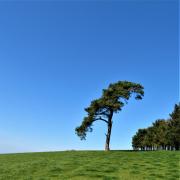The year progresses. Autumn has segued into winter, deciduous trees losing their glorious autumn palette as they surrender leaves to winter winds. Their arboreal forms are now beautifully discernible, branches and twigs a skeletal lace against the sky.
For trees and hedges this is a time of dormancy, of resting – and for centuries this has been the time when ‘hedgelaying’ takes place, a traditional system of management which may look drastic, but which ensures the long-term continuity and regeneration of a hedge, and which plays an important role within the ecosystem.
So, on a cold November morning, I find myself beside a hedge that flanks an ancient trackway, as conservation volunteer, Tony Byrne, gets to work. The last few hazel leaves are clinging on, but this hedge is ready for laying. He explains the process:


‘When faced with a hedge to lay, the first task is to go through the lower part and remove superfluous growth, such as bramble. Then you assess how thick the hedge is, is there too much growth to lay, with lots of vertical stems that need thinning out? If so, some of these are removed with a pruning saw or loppers, leaving tall stems, called ‘pleachers’, that will now be laid.’
To start the process of laying, the hedger creates space at one end of the hedge to lay into, by coppicing out some uprights. Then, using a billhook or hatchet, he takes the first pleacher and cuts obliquely and smoothly down through about 80 per cent of the stem, on the opposite side to the direction of laying. Once horizontal, the stem can be tidied up, removing excess sideshoots so that it lies horizontally. This is repeated with each pleacher. When there are several horizontal stems these, if needed, can be secured in place with forked sticks – a traditional Devon style of working. The hedger works like this along the length of the hedge.
‘If there is a gradient to the hedge,’ says Tony, ‘it needs to be laid uphill, so that sap can rise through the stem, passing through the still-attached live tissue and enabling new growth. Hedgelaying will be repeated every 10 to 15 years, so you’ll often see evidence of earlier laying.’
Devon-based ecologist Rod Lawrence explains the benefits of hedgelaying.

‘When you lay a hedge you are exploiting a process known as phototropism where plants grow towards the light. If you cut and lay the branches nearly horizontally, vertical shoots will develop all along the branch to create a dense, stock-proof hedge with wildlife cover right to the ground. This cover creates a secure highway for wildlife to travel, creating corridors linking one habitat to another. A well-laid hedge provides better security for nesting birds and mammals, including dormice.
‘If you don’t lay your hedge and just trim the top, what tends to happen is that the top becomes dense, shading the bottom of the hedge. This causes the base of the hedge to become gappy, so it’s not stock-proof for farm animals and offers less habitat provision for wildlife.’
The hedge plants can be indicators of the estimated age of a long-established hedge, using a simplified version of a calculation known as Hooper’s Rule.
Rod says: ‘If you count the number of woody species over a 30m length of hedge, each species represents, approximately, 100 years. You need to take an average of several 30m lengths and you don’t count species such as roses, ivy and honeysuckle. Obviously, you can’t do this on a recently planted hedge, you must be sure it’s ancient hedgerow.’

In terms of biodiversity, a good hedge can be supreme: one two-year study on an 85m stretch of Devon hedge revealed, staggeringly, more than 2,000 species of plants, animals and macro fungi.
Andrew Hughes is a Fellow of the Royal Agricultural Society and was awarded Farmer of the Year in 2011 by BBC Radio 4s’s Food and Farming Awards. This was in recognition of his sustainable practices and efficient, high-quality food production with sound consideration for environmental care.
Andrew now farms in Mid Devon and says that, in terms of resources, hedgelaying is preferable to flail-cutting as it naturally maintains a stock-proof barrier, which means that it replaces the need for stakes and barbed-wire fencing. It enables gaps that have developed to be filled by existing hedgerow plants, rather than having to source new material.
He says hedgelaying is ‘an excellent provision of rural employment and the finished hedge looks more attractive and in keeping with the local character. The process is much more environmentally sustainable and can work out to be more cost-effective in the long run.’

‘If a laid hedge is looked after it can last for years and deliver a boost to our much-needed wildlife, with more flowers and fruit,’ he adds.
The ’local character’ in Devon sees hedges laid close to the soil on top of traditional hedgebanks.
Often, as I roam the countryside, I spot evidence of hedgelaying: recently laid hedges as well as ancient examples of the practice, where thick, horizontal branches at the bottom are topped by a proliferation of upright growth. These hedges are living evidence of working with nature in a traditional fashion that still meets modern-day needs.
To the hedgers of the past, we salute you; to those of the present and the future – all power to your billhooks!
ENVIRONMENTAL BONUS
After the Second World War farmers were incentivised to remove hedging in a bid for self-sufficiency but without consideration for the negative environmental impact. Now, in a reversal, governmentdriven environmental schemes are assisting hedge restoration. Individuals are also opting to do something for the greater good by planting and caring for hedges. People’s Trust for Endangered Species (PTES) says that about half the UK’s hedgerows have been lost over the last century through incentivised removal, which makes those that remain even more valuable. The charity says hedges also offer crop protection and act as livestock shelters. They can provide income and benefit the environment by acting as carbon stores. They help to reduce flooding, soil erosion, and air and water pollution levels. The trust’s free Healthy Hedgerows app offers hedgerow management advice to farmers, landowners and land managers, making hedgerow management planning easier. ptes.org/hedgerow
LEARNING THE SKILL
Recognising the importance of preserving our hedges in good condition, various organisations teach traditional hedge maintenance. The Blackdown Hills Hedge Association (BHHA) is ‘dedicated to preserving the craft of hedgelaying and other related skills’. It runs courses during autumn and winter, for those who wish to learn how to manage hedges for themselves. The association also organises an annual Skills of the Hills competition, comprising five different classes: Novice, Novice Pairs, Intermediate, Intermediate Pairs and Open. bhha.info

































